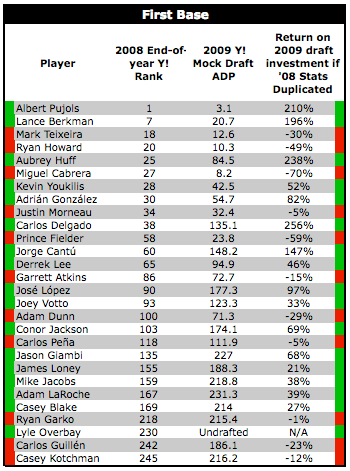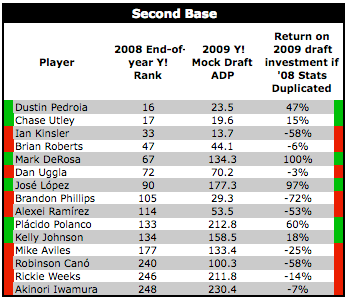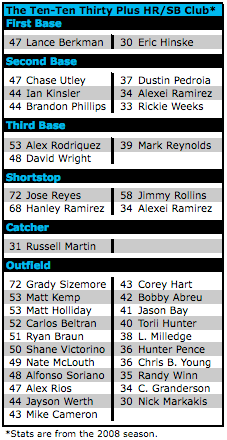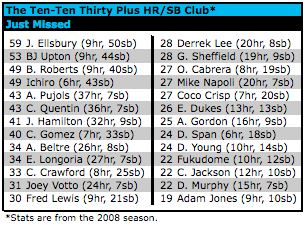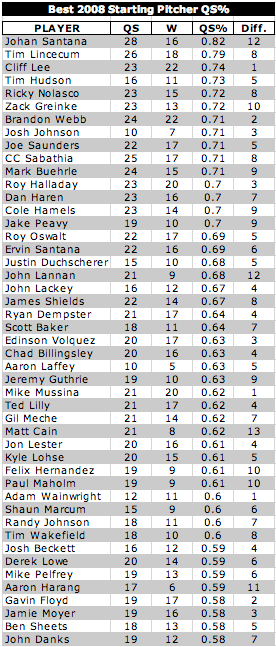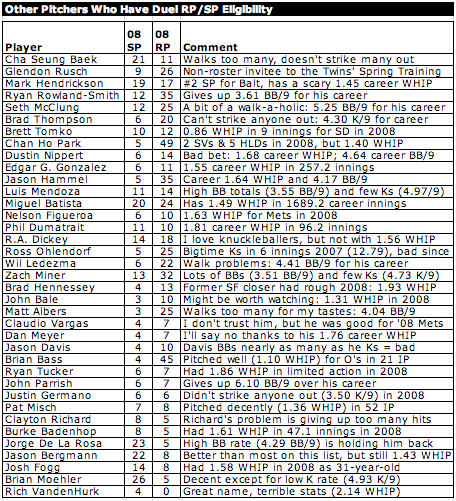
In 2008, the Chicago Cubs were swept away in another first round playoff series, this time to an inferior Los Angeles Dodgers team. Still, the 2008 Chicago Cubs won 97 games, led all of baseball in run differential, strikeouts, batting average against, fifth in WHIP, fifth in batting average, and second in on-base percentage. And yet, the team did not have one fantasy superstar. Sure, there were moments when the Lovable Lou Pinellas put up numbers worthy of starting status, but by and large the North Siders were a team of great depth and chemistry, built well for the regular season, unwell for the post-season. Nevertheless, the team has fantasy potential worth exploring.
Top Five 2009 fantasy contributors:
1.
Alfonso Soriano: Outfielder Alfonso Soriano, still looking slick in his well-fitting uniform and slightly less slick taking his odd bounce-hop before catching or not catching routine fly balls, is no longer a certain fantasy stud. In fact, his dubious hamstrings, chameleonic nature at the plate – one moment patient and destructive, the next lost and feeble – and age has made him a fringe second-rounder.
Although Soriano was able to put up a line of 29 HR, 75 RBI, 76 R, 19 SB, and a .280 AVG, all in 109 games, the 33 year old has missed 80 games over the past two years, mostly a result of his bum hamstrings. He’s no longer a candidate for 30 steals, for even when he’s healthy, he has only mild interest in swiping a base. And if he eventually moves to the middle of the lineup – where he belongs – his stolen bases will drop even further.
Soriano can still carry a fantasy team for short periods of time. When he gets hot he can crush 10 homers, steal a half-dozen bases, and hit over .400 in a week. But he can just as easily fall into a slump that makes you consider relegating him to your bench.
The virtue and attraction of Soriano in his prime, aside from his 2B eligibility, was his 40-40 potential. You could live with his aggressive swinging because it more often than not yielded favorable results. And pitchers couldn't risk pitching around him because of his baserunning prowess. But that threat has mostly passed.
Soriano will likely put up similar numbers this year as in 2008, but the bottom line is that his inconsistency at the plate, diminished health, and reluctance to take many chances on the basepaths make him no better than a low second-rounder, high third-rounder.
2.
Geovany Soto: Catcher Geovany Soto may not put up the numbers Derrek Lee or Aramis Ramirez ultimately produce, but his eligibility at a premium position makes his value much greater. The National League Rookie of the year hit .285 with 23 bombs, 86 RBI, 66 runs scored and 1 CS. Okay, so he’s no speed demon like Russell Martin. But the rest of his line is pretty darn good. And at 25, he’s likely to continue to improve.
Soto has 25-30 homerun power, is patient at the plate – backed by his 62 walks and .364 OBP – and is above-average defensively, which doesn’t directly factor into his fantasy stats, but does allow Pinella to keep him out there in the late-innings when defensive replacements often arrive.
Soto often batted at the bottom of the lineup, but with Lee’s homerun power disappearing, and overachieving Mark DeRosa now in Cleveland, Soto may stay somewhere in the middle, perhaps behind Ramirez or the fragile Milton Bradley, whose OBP can only help Soto’s RBI total.
There are other quality catchers out there, including the aforementioned Martin, pudgy Braves catcher Brian McCann, Twins heartthrob Joe Mauer, and the Indians Victor Martinez; Soto belongs in their class.
3.
Aramis Ramirez: Although he’s set to turn 31 in June, third baseman Aramis Ramirez is still one of the premier players at his position. In his five full seasons with the Cubs, he has averaged 31 homeruns, 105 RBI, and a .301 batting average. That’s excellent work. In addition, he’s become more patient at the plate, with 74 walks to 94 strikeouts, and a .380 OBP. He won’t steal you bases, and he has a penchant to miss time with nagging injuries, but you certainly could do worse with Aramis as your hot corner representative.
There is concern, however, that the departure of Utility giant Mark DeRosa, who often gave Aramis the much-needed and precautionary days off, combined with the lack of a serviceable replacement, may force Pinella to play Ramirez more. This could result in a longer stint on the DL, even by Aramis’ standards.
Having Milton Bradley in the lineup, even if it’s only for 100 games or so, should allow Ramirez to get a better pitch selection, which, with his keen eye, will allow him to sit back and wait for that ball he can power over Waveland Avenue.
It’s a fair to expect numbers in line with his career Cubbie average, but fantasy owners should be cautioned that he’s an injury risk and selecting a competent backup in the later rounds would be prudent.
4.
Carlos Marmol: For a two-week stretch just before the all-star game, reliever and potential closer Carlos Marmol decided to mimic Penal League pitcher Ricky Vaughn’s game. Perhaps Marmol was a fan of the movie, or curious about what it’s like to be Charlie Sheen, minus the cost of hookers and undeserved Emmy nominations. Either way, the break seemed to be the remedy to his two-week hiatus from this planet, unlike Vaughn, who needed an eye exam and thick black-framed glasses.
There are many pundits who rank Marmol outside of the top ten of 2009 closers. And there is merit to these rankings. First, he hasn’t even been named the closer. Pinella has announced that he will compete with newly acquired Kevin Gregg to replace the beloved, star-crossed closer Kerry Wood. Next, Marmol has never been a closer. In two years as a reliever, he has eight saves, seven of which came last year when Wood was out with a blister. He also has three blown saves. Lastly, in both seasons, he’s lost his command. Like all major leaguers at some point during the season, he’s slumped. And his slumps, like many players, have come and gone with no real warning. For a hitter, it’s par for the course. But for closers, who appear in such a relatively minimal number of games, a two-week slump can be devastating, especially for fantasy owners, who count on their closers being consistent.
However, when he’s on – which is most of the time – no reliever in baseball has better stuff. This includes Papelbon, Nathan, Soria, K-Rod, Lidge, and the all-time master, Mo Rivera. While these pitchers will blow hitters away, Marmol will embarrass them. Routinely, hitters flail at strike three and walk to their dugout shrugging their shoulders. The combination of his mid-nineties fastball and a slider in the high-eighties that has other-worldly movement gives hitters fits. His numbers are predictably impressive.
His ERA of 2.68 would have been considerably better without the month of June, when he posted a 7.36 ERA. Still, a sub-3 ERA for a relief pitcher with 87 IP is not bad. But his other stats are simply video game-esque. He had 114 strikeouts in those 87 innings to just 40 hits, and 41 walks. He surrendered 10 homeruns. His strikeout-to-hit ratio was one of the best in major league history.
Although Marmol does have competition in Gregg, and in many ways Marmol would be more valuable in his current role because he’d be able to pitch in either the seventh, eighth, or ninth, rather than just in save situations, Gregg’s general ineffectiveness as a closer and Marmol’s arsenal make him nearly a sure thing to inherit the role at the end of spring training. In addition, the reduction in innings the position brings would likely help Marmol, who’s mid-season swoon may have been a result of overwork.
Expectations should be tempered until it’s known that he can handle the pressure that comes with being a closer, but the likelihood is that he can, and he may put up the best numbers of any closer in baseball.
5.
Derrek Lee: Derrek Lee will never return to his 2005 form, when he contended for the triple crown, and finished third in the MVP voting, an award he deserved to win. His 2006 wrist injury stripped him of much of his power, and perhaps as precaution, his swing has leveled off, which may not put as much stress on his wrists, but also reduces the elevation of his fly balls, which, in 2008, resulted in many bouncing off the ivy at Wrigley instead of into the basket. He still hit .291 with 90 RBI and 93 runs, but for a corner infielder hitting in the middle of a very strong offense, those numbers are merely adequate.
Lee is still a good hitter. He had a .361 OBP with 41 doubles, and seemed to be the only Cub hitter to show up in the playoffs. Not to be overlooked is his durability, which, other than the wrist injury, is unquestioned. You can count on Lee to be in the field for 150-155 games, and most of those games will be productive. He won’t have the hot streaks Soriano produces, but he also won’t have the slumps.
It’s possible he could hit .300 with 25 homeruns, but I’d take the under. At 33, his career is certainly winding down. But like the rest of the Cubs, hitting with support in front and behind is always beneficial to ones stats.
Last Thoughts:
Two Cubs players who would be in the top five based on talent alone, Rich Harden and Milton Bradley, are too injury prone to be counted on for a full fantasy season. Both are worthy of roster spots, and perhaps you’ll get lucky—as Harden owners were this past season—but being cynical of their future health is the right mentality. Plus, how long will it take Bradley to scale the ivy walls and slap around a fan with his mitt? The bleacher bums get cavalier with their monosyllabic adjectives in the late innings, and Bradley, perhaps mired in a slump, will receive too many of those words to ignore his instincts.
Other interesting Cubs-related reads:
Razzball has a Cubs fantasy preview. He is wrong about Soriano, but, oh, so right about Lee and sandwiches.
FB Junkie: Is Milton Bradly underrated?Is Samardzija worth watching?
 Mark DeRosa turned 34 years old two days ago. Happy belated birthday, Mark. For your birthday I am going to give you something that no one else has given you recently: a post all of your own.
Mark DeRosa turned 34 years old two days ago. Happy belated birthday, Mark. For your birthday I am going to give you something that no one else has given you recently: a post all of your own.


